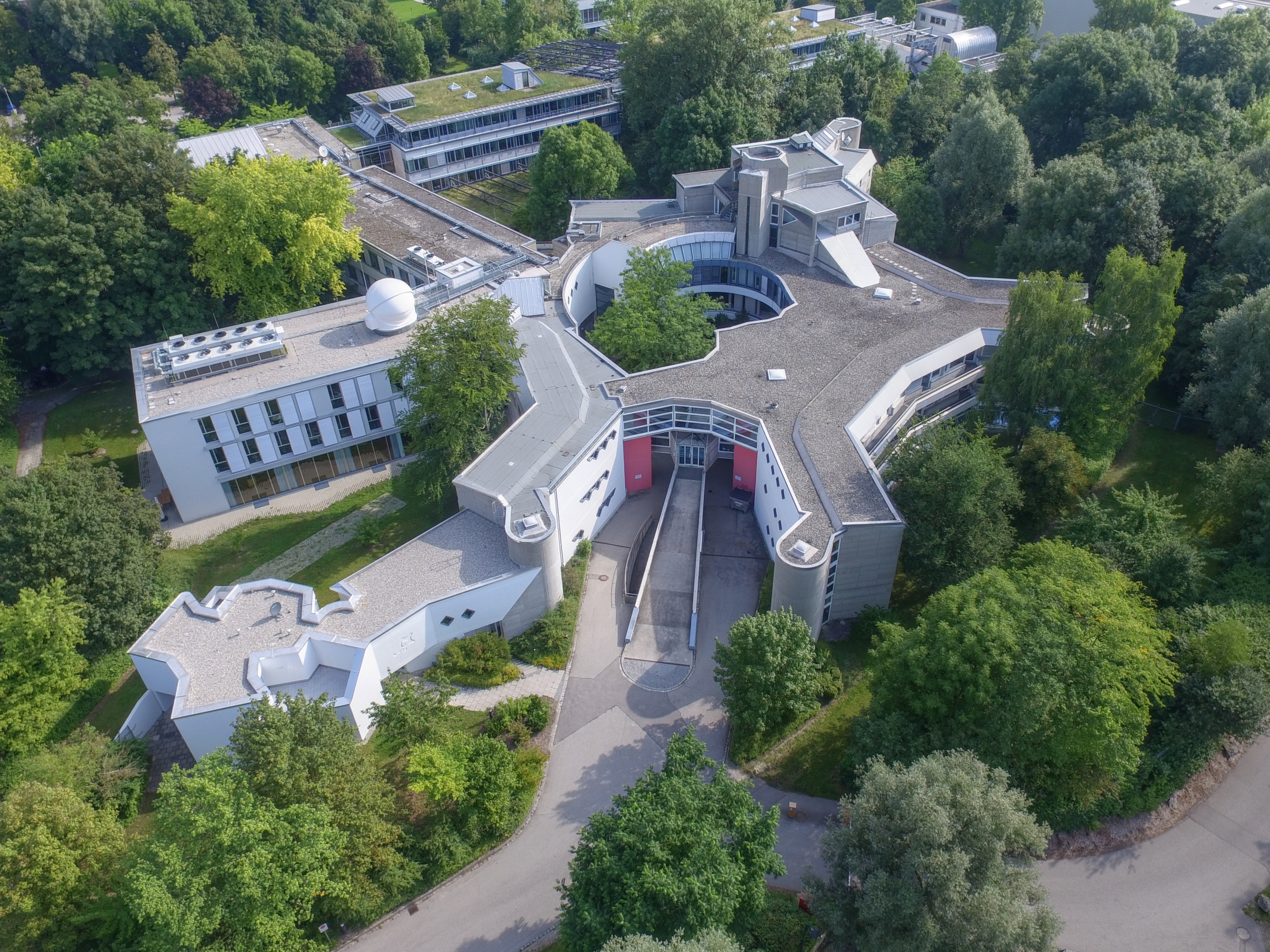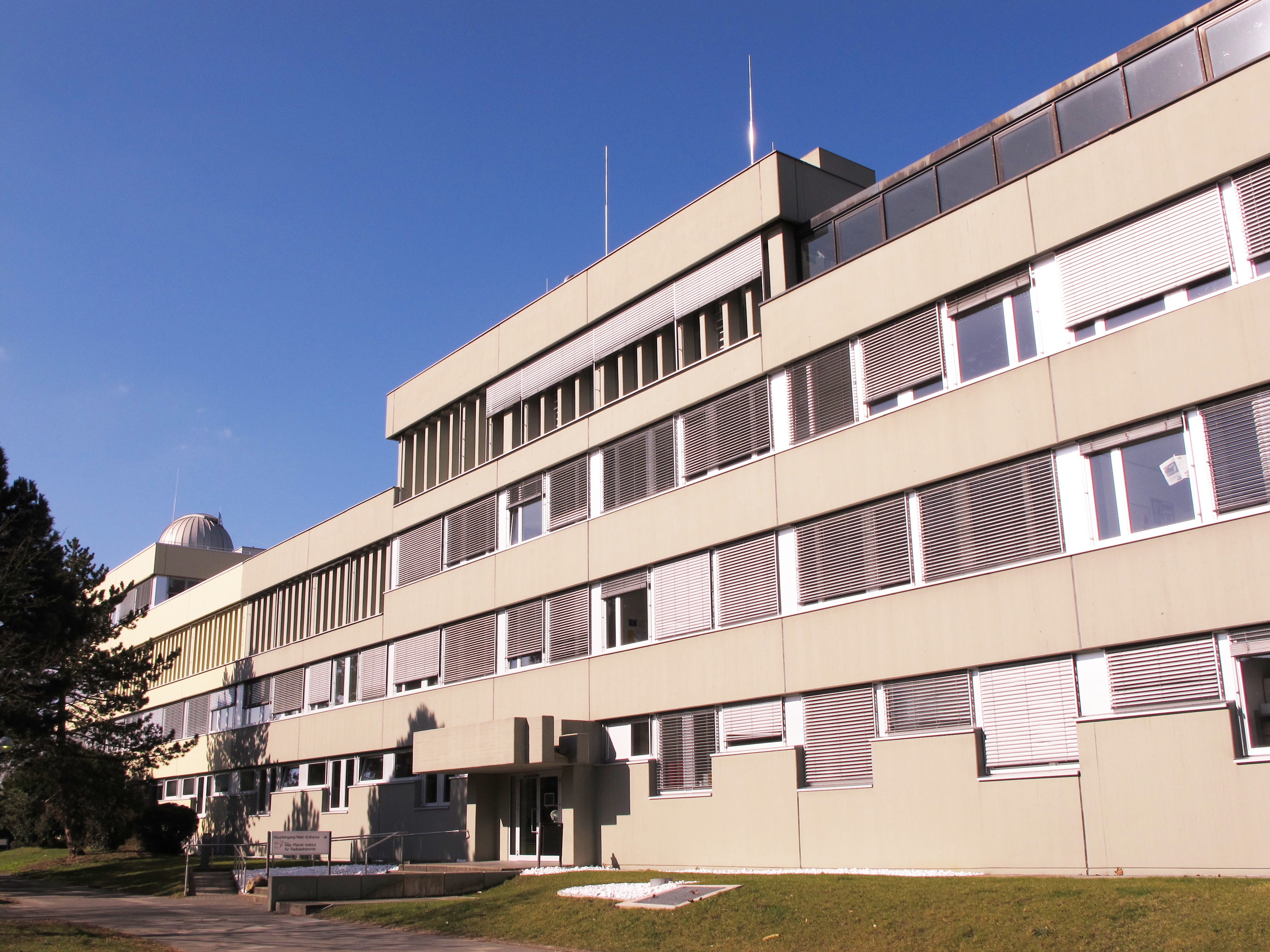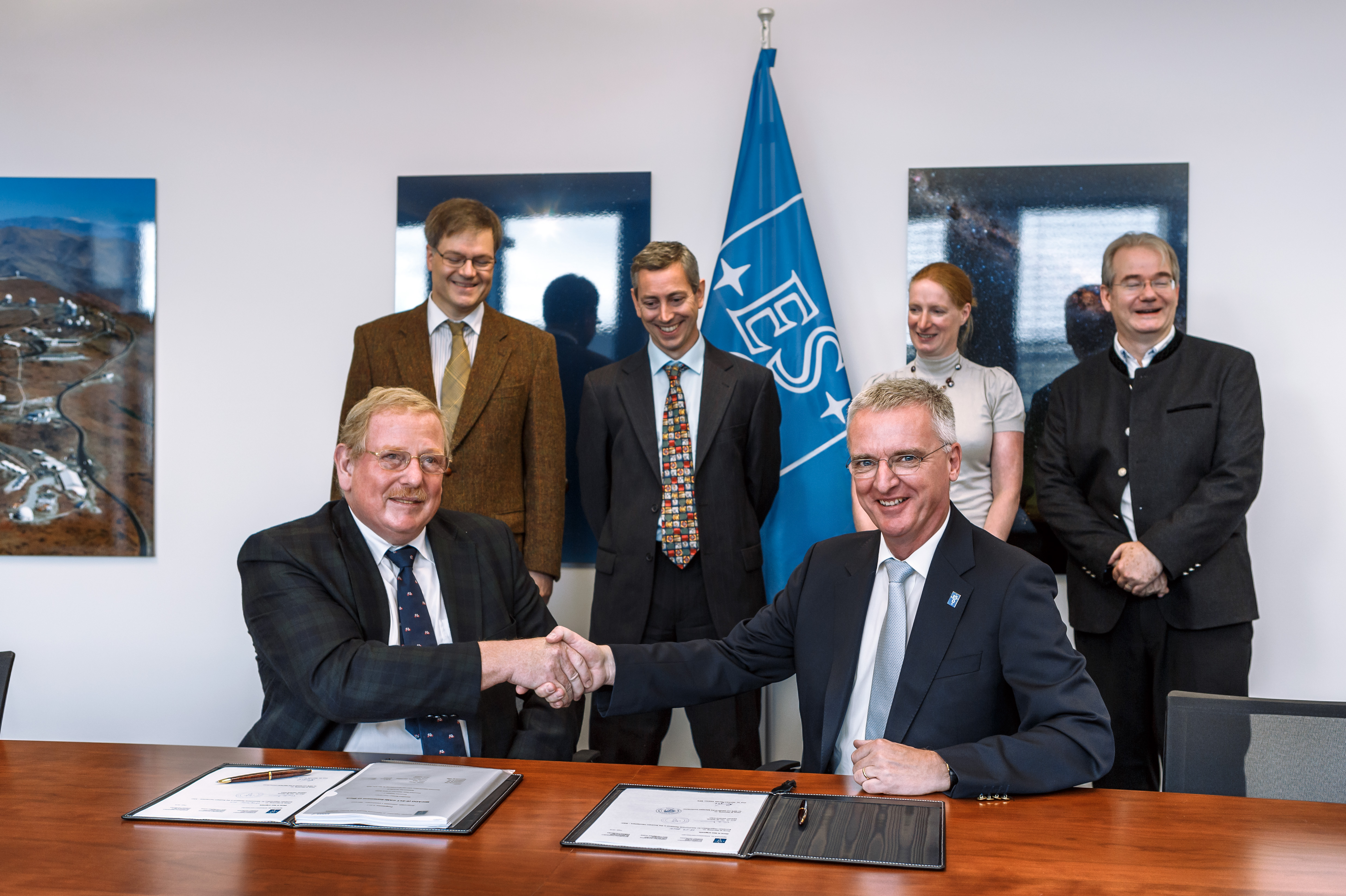|
Max Planck Institute For Astrophysics
The Max Planck Institute for Astrophysics (MPA) is a research institute located in Garching, just north of Munich, Bavaria, Germany. It is one of many scientific research institutes belonging to the Max Planck Society. The MPA is widely considered to be one of the leading institutions in the world for theoretical astrophysics research. According to Thomson Reuters, from 1999-2009 the Max Planck Society as a whole published more papers and accumulated more citations in the fields of physics and space science than any other research organization in the world. History The Max Planck Society was founded on 26 February 1948. It effectively replaced the Kaiser Wilhelm Society for the Advancement of Science, which was dissolved after World War II. The society is named after Max Planck, one of the founders of quantum theory. The MPA was founded as the Max Planck Institute for Physics and Astrophysics in 1958 and split into the Max Planck Institute for Astrophysics and the Max Planck ... [...More Info...] [...Related Items...] OR: [Wikipedia] [Google] [Baidu] |
Max Planck Institute For Physics
The Max Planck Institute for Physics (MPP) is a physics institute in Munich, Germany that specializes in high energy physics and astroparticle physics. It is part of the Max-Planck-Gesellschaft and is also known as the Werner Heisenberg Institute, after its first director in its current location. The founding of the institute traces back to 1914, as an idea from Fritz Haber, Walther Nernst, Max Planck, Emil Warburg, Heinrich Rubens. On October 1, 1917, the institute was officially founded in Berlin as '' Kaiser-Wilhelm-Institut für Physik'' (KWIP, Kaiser Wilhelm Institute for Physics) with Albert Einstein as the first head director.Geschichte " (in German). Max Planck Institute for Physics. Abbreviated version in English: [...More Info...] [...Related Items...] OR: [Wikipedia] [Google] [Baidu] |
Selma De Mink
Selma de Mink is a Dutch astrophysicist specializing in evolution of stars, stellar binary systems and compact objects, including black holes. She is a scientific director at the Max Planck Institute for Astrophysics in Garching near Munich, Germany. Early life and education Selma de Mink was born in the Netherlands. She graduated from Utrecht University in the Netherlands in 2010 with a Ph.D. in Astronomy, and in 2005 with an MSc in Astrophysics, BSc in Physics and BSc in Applied Math (all cum laude). Career From 2019 to 2020 she was an associate professor at the Harvard University Astronomy Department, with appointments at the Center for Astrophysics , Harvard & Smithsonian (CfA) and Black Hole Initiative (BHI) at Harvard. As of 2021 she is scientific director of the stellar astrophysics department at the Max Planck Institute for Astrophysics (MPA) in Garching, Germany. Research In a 2012 paper in ''Science'', De Mink and her collaborators determined that binary ... [...More Info...] [...Related Items...] OR: [Wikipedia] [Google] [Baidu] |
Doctor Of Philosophy
A Doctor of Philosophy (PhD, Ph.D., or DPhil; Latin: or ') is the most common degree at the highest academic level awarded following a course of study. PhDs are awarded for programs across the whole breadth of academic fields. Because it is an earned research degree, those studying for a PhD are required to produce original research that expands the boundaries of knowledge, normally in the form of a dissertation, and defend their work before a panel of other experts in the field. The completion of a PhD is often a requirement for employment as a university professor, researcher, or scientist in many fields. Individuals who have earned a Doctor of Philosophy degree may, in many jurisdictions, use the title '' Doctor'' (often abbreviated "Dr" or "Dr.") with their name, although the proper etiquette associated with this usage may also be subject to the professional ethics of their own scholarly field, culture, or society. Those who teach at universities or work in academic, e ... [...More Info...] [...Related Items...] OR: [Wikipedia] [Google] [Baidu] |
Technical University Munich
The Technical University of Munich (TUM or TU Munich; german: Technische Universität München) is a public research university in Munich, Germany. It specializes in engineering, technology, medicine, and applied and natural sciences. Established in 1868 by King Ludwig II of Bavaria, the university now has additional campuses in Garching, Freising, Heilbronn, Straubing, and Singapore, with the Garching campus being its largest. The university is organized into eight schools and departments, and is supported by numerous research centers. It is one of the largest universities in Germany, with 50,000 students and an annual budget of €1,770.3 million (including university hospital). A ''University of Excellence'' under the German Universities Excellence Initiative, TUM is considered the top university in Germany according to major rankings as of 2022 and is among the leading universities in the European Union. Its researchers and alumni include 18 Nobel laureates and 23 Leibniz ... [...More Info...] [...Related Items...] OR: [Wikipedia] [Google] [Baidu] |
Ludwig Maximilian University Of Munich
The Ludwig Maximilian University of Munich (simply University of Munich or LMU; german: link=no, Ludwig-Maximilians-Universität München) is a public research university in Munich, Bavaria, Germany. Originally established as the University of Ingolstadt in 1472 by Duke Ludwig IX of Bavaria-Landshut, it is Germany's sixth-oldest university in continuous operation. In 1800, the university was moved from Ingolstadt to Landshut by King Maximilian I Joseph of Bavaria when the city was threatened by the French, before being transferred to its present-day location in Munich in 1826 by King Ludwig I of Bavaria. In 1802, the university was officially named Ludwig-Maximilians-Universität by King Maximilian I of Bavaria in honor of himself and Ludwig IX. LMU is currently the second-largest university in Germany in terms of student population; in the 2018/19 winter semester, the university had a total of 51,606 matriculated students. Of these, 9,424 were freshmen, while international ... [...More Info...] [...Related Items...] OR: [Wikipedia] [Google] [Baidu] |
European Southern Observatory
The European Organisation for Astronomical Research in the Southern Hemisphere, commonly referred to as the European Southern Observatory (ESO), is an intergovernmental organization, intergovernmental research organisation made up of 16 member states for ground-based astronomy. Created in 1962, ESO has provided astronomers with state-of-the-art research facilities and access to the southern sky. The organisation employs about 730 staff members and receives annual member state contributions of approximately €162 million. Its observatories are located in northern Chile. ESO has built and operated some of the largest and most technologically advanced telescopes. These include the 3.6 m New Technology Telescope, an early pioneer in the use of active optics, and the Very Large Telescope (VLT), which consists of four individual 8.2 m telescopes and four smaller auxiliary telescopes which can all work together or separately. The Atacama Large Millimeter Array observes the un ... [...More Info...] [...Related Items...] OR: [Wikipedia] [Google] [Baidu] |
Max Planck Institute For Solar System Research
The Max Planck Institute for Solar System Research (abbreviation: MPS; german: Max-Planck-Institut für Sonnensystemforschung) is a research institute in astronomy and astrophysics located in Göttingen, Germany, where it relocated in February 2014 from the nearby village of Lindau. The exploration of the Solar System is the central theme for research done at this institute. MPS is a part of the Max Planck Society, which operates 80 research facilities in Germany. Research MPS is organised in three departments: Sun and Heliosphere, Planets and Comets, and Solar and Stellar Interiors. In addition, since 2002 there is also an International Max Planck Research School. Subjects of research at the institute are the various objects within the solar system. A major area of study concerns the Sun, its atmosphere, the interplanetary medium as influenced by the solar wind, as well as the impact of solar particles and radiation on the planets. The second area of research involves the ... [...More Info...] [...Related Items...] OR: [Wikipedia] [Google] [Baidu] |
Max Planck Institute For Radio Astronomy
The Max Planck Institute for Radio Astronomy (MPIfRA) (German: ''Max-Planck-Institut für Radioastronomie'') is located in Bonn, Germany. It is one of 80 institutes in the Max Planck Society (German: Max-Planck-Gesellschaft). History By combining the already existing radio astronomy faculty of the University of Bonn led by Otto Hachenberg with the new Max Planck institute the Max Planck Institute for Radio Astronomy was formed. In 1972 the 100-m radio telescope in Effelsberg was opened. The institute building was enlarged in 1983 and 2002. The southern wing of the whole complex is occupied by the Argelander Institute of Astronomy of the University of Bonn. Structure The Institute has three main research groups, each with its own Director Departments * Fundamental Physics ( Michael Kramer) * VLBI and Radio Astronomy ( Anton Zensus) * Millimetre Astronomy ( Karl Menten) Independent Research Groups * Lise Meitner Group on Fast Radio Bursts as Astrophysical Tools ... [...More Info...] [...Related Items...] OR: [Wikipedia] [Google] [Baidu] |
Max Planck Institute For Astronomy
The Max-Planck-Institut für Astronomie (Max Planck Institute for Astronomy, MPIA) is a research institute of the Max Planck Society (MPG). It is located in Heidelberg, Baden-Württemberg, Germany near the top of the Königstuhl, adjacent to the historic Landessternwarte Heidelberg-Königstuhl astronomical observatory. The institute primarily conducts basic research in the natural sciences in the field of astronomy. In addition to its own astronomical observations and astronomical research, the Institute is also actively involved in the development of observation instruments. The instruments or parts of them are manufactured in the institute's own workshops. History The founding of the institute in 1967 resulted from the insight that a supra-regional institute equipped with powerful telescopes was necessary in order to conduct internationally competitive astronomical research. Hans Elsässer, an astronomer, became the founding director in 1968. In February 1969, a first gro ... [...More Info...] [...Related Items...] OR: [Wikipedia] [Google] [Baidu] |
Max Planck Institute For Extraterrestrial Physics
The Max Planck Institute for Extraterrestrial Physics is a Max Planck Institute, located in Garching, near Munich, Germany. In 1991 the Max Planck Institute for Physics and Astrophysics split up into the Max Planck Institute for Extraterrestrial Physics, the Max Planck Institute for Physics and the Max Planck Institute for Astrophysics. The Max Planck Institute for Extraterrestrial Physics was founded as sub-institute in 1963. The scientific activities of the institute are mostly devoted to astrophysics with telescopes orbiting in space. A large amount of the resources are spent for studying black holes in the galaxy and in the remote universe. History The Max-Planck-Institute for extraterrestrial physics (MPE) was preceded by the department for extraterrestrial physics in the Max-Planck-Institute for physics and astrophysics. This department was established by Professor Reimar Lüst on October 23, 1961. A Max-Planck Senate resolution transformed this department into a sub-inst ... [...More Info...] [...Related Items...] OR: [Wikipedia] [Google] [Baidu] |
Astrophysics
Astrophysics is a science that employs the methods and principles of physics and chemistry in the study of astronomical objects and phenomena. As one of the founders of the discipline said, Astrophysics "seeks to ascertain the nature of the heavenly bodies, rather than their positions or motions in space–''what'' they are, rather than ''where'' they are." Among the subjects studied are the Sun, other stars, galaxies, extrasolar planets, the interstellar medium and the cosmic microwave background. Emissions from these objects are examined across all parts of the electromagnetic spectrum, and the properties examined include luminosity, density, temperature, and chemical composition. Because astrophysics is a very broad subject, ''astrophysicists'' apply concepts and methods from many disciplines of physics, including classical mechanics, electromagnetism, statistical mechanics, thermodynamics, quantum mechanics, relativity, nuclear and particle physics, and atomic a ... [...More Info...] [...Related Items...] OR: [Wikipedia] [Google] [Baidu] |







